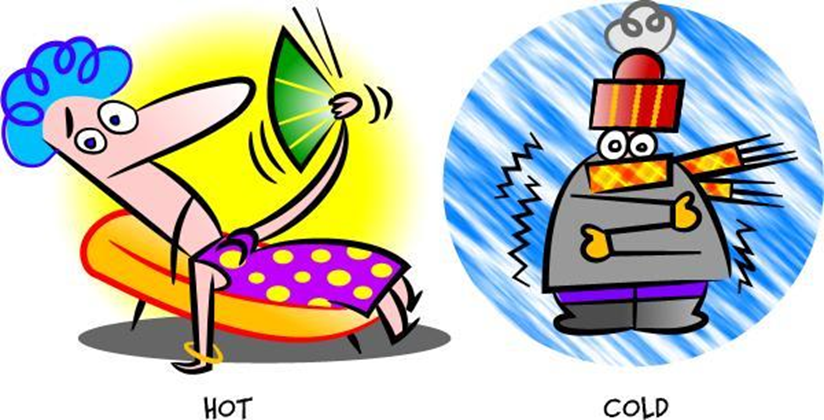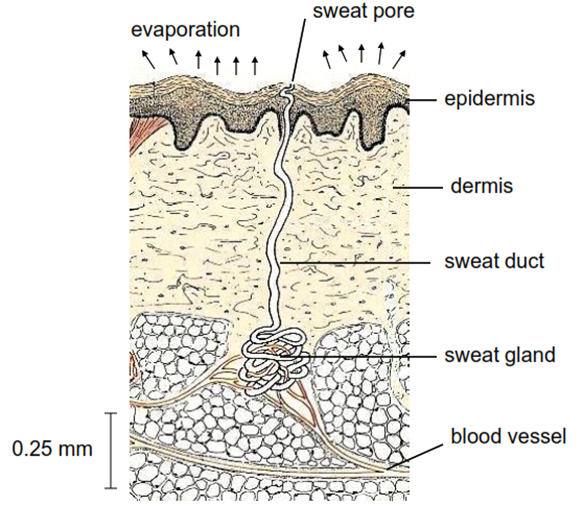Homeostasis
Objectives
At the end of this lecture, students will be able to –
• Explain Homeostasis
• Describe the importance of homeostasis
• Explain role of different organ systems in maintaining body’s environment
• List out components of homeostasis system
• Explain mechanism involved in the internal environment
maintenance
• Describe feedback loop
LIFE’S BALANCING ACT
• If you are too hot or too cold your body temeruture is out of balance.
• When we are too cold we shiver, it warms us up
• When we are too hot we sweat, it cools us down.
Homeostasis
• Greek words; Homeo = ‘unchanging’ and Stasis = ‘standing’
• In its simplest form it means ‘staying the same’
• It is an organism’s internal environment which ‘stays the
same’
• So, a better definition of ‘homeostasis’ is the maintenance of the internal environment within narrow limits
• In practice, it comes down to providing a stable environment for the cells of the body
• The living processes in the cells depend on the activity
of enzymes.
• These enzymes work best in specific conditions such as
those of temperature and pH.
• Any change in these conditions affects the function of the enzymes and may lead to the death of the cells or, ultimately, the whole organism
• Internal conditions are not absolutely constant, but allowed to vary within very narrow limits.
Ex: Human body temperature varies between 36.1 – 37.8 oC.
The average temperature is usually expressed as 36.8 oC
• There is no specific organ which controls homeostasis
except, possibly, the brain
• The skin, kidneys, liver, endocrine system, nervous system
and sensory system all play a part in maintaining the internal environment within narrow limits
ALL ORGANS AND ORGAN SYSTEMS OF THE BODY HELP IN MAINTENANCE OF HOMEOSTASIS
• Cardiovascular system.
• Respiratory system.
• Nervous system.
• Endocrine system.
• Gastrointestinal system.
• Excretory system.
• Skeletal system.
• Integumentary system.
• Reproductive system.
CARDIOVASCULAR SYSTEM
• Transports oxygen, carbon dioxide, nutrients and hormones
to and from the body cells.
• Helps regulate pH and temperature.
• Provides protection against diseases.
• To carry out its living processes, every cell in the body
needs a supply of oxygen and food. Waste products such as carbon dioxide have to be removed before they reach harmful levels and damage the cell
• These conditions are maintained by tissue fluid bathing
the cells. Tissue fluid is derived from the blood
• The tissue fluid contains oxygen and food which the cells
can absorb, and also accepts the carbon dioxide and other waste products produced by the cells
• The blood system maintains the composition of the tissue
fluid cells
• One important method of achieving homeostasis is negative feedback
• It applies to many systems in the body. Temperature
regulation is one example
• If the blood temperature rises, a ‘heat gain’ centre in
the brain sends nerve impulses to the skin, which causes vasodilation and sweating, which cool the blood
• If the blood temperature falls, it stimulates a ‘heat loss’ centre in the brain which sends impulse to the skin causing vasoconstriction and the cessation of sweating. These changes reduce heat loss from the skin
• The warmer or cooler blood provides negative feedback to the thermoregulatory centre in the brain
RESPIRATORY SYSTEM
• Exchange the gases between atmospheric air and blood.
• Help adjust the pH of the body fluids.
NERVOUS SYSTEM
• Generates nerve impulses (Action Potential) that provide
communication and regulation of most body tissues.
ENDOCRINE SYSTEM
• Regulates the activity and growth of target cells in the
body.
• Regulate metabolism
• The glucose concentration in the blood is controlled by
the pancreas
• The pancreas contains cells which produce digestive enzymes but it also contains cells (alpha and beta cells) which produce the hormones insulin and glucagon
• If the glucose concentration rises, the beta cells release
insulin
• If the glucose concentration falls, the alpha cells release glucagon
• Insulin stimulates the liver and muscles to remove excess glucose from the blood and store it as glycogen
• Glucagon stimulates the liver to convert its stored glycogen into glucose which is then released into the bloodstream
• In this way, the concentration of glucose in the blood is kept within narrow limits
GASTROINTESTINAL SYSTEM
• Breaks down food into absorbable form.
• Absorbs various nutrients.
• Eliminates waste from the body.
EXCRETORY SYSTEM
• Helps eliminate the waste products from the body.
• Maintains the blood pH, volume, pressure, osmolarity, electrolyte composition etc.
• Produces hormones.
• In the cells, the chemical breakdown of proteins produces the nitrogenous compound, urea. If this were allowed to accumulate in the cells it would damage or kill them.
• The concentration of the blood and tissue fluids tends to vary. If water is lost through evaporation and sweating, the fluids become more concentrated. The intake of water dilutes the fluids
• It is important that the concentration of blood and tissue
fluid is kept within narrow limits if the cells are to function properly
• These homeostatic functions are carried out by the kidneys
Microscopic slice of kidney tissue:
Blood pressure forces tissue fluid out of a clump of narrow
capillaries
The fluid contains urea, salts, glucose and other soluble
substances
The fluid trickles down this tubule and the useful substances
such as glucose are reabsorbed into the blood
In this tubule more or less water is reabsorbed to maintain
the blood concentration
Excess water, some salts and urea collect here before
passing to the bladder as urine
SKELETAL SYSTEM
• Bones provide support, protection, the production of blood
cells.
• Muscles produce body movements and produce heat to
maintain the body temperature.
INTEGUMENTARY SYSTEM
• Contributes to homeostasis by protecting the body and
helping regulate the body temperature
• It also allows you to sense pleasurable, painful and other
stimuli in your external environment.
Section through skin
The sweat gland extracts sweat from the blood and passes it up the duct to the skin surface where it evaporates
Vasodilation
If the body temperature rises, the blood vessels in the skin
dilate (become wider) and allow more blood to flow near the surface. The heat loss from the blood through the skin helps cool the circulating blood much heat lost
Vasoconstriction
If the body temperature falls. The blood vessels in the skin
constrict. Less warm blood flows near the surface so less heat is lost
HOW HOMEOSTATIC CONTROL MECHANISMS WORK?
• Homeostatic control mechanisms work through ‘Feedback Mechanisms’.
• Status of a body condition is continually monitored, evaluated, changed, re-monitored & reevaluated.
FEEDBACK MECHANISM
• A feedback mechanism is a cycle in which the output of a
system “feeds back” to either modify or reinforce the action taken by the system.
• A feedback mechanism may operate at:
– Tissue level
– Organ level
– Organ system level
– Body level, integrating with other organ systems.
• Feedback mechanism can be:
– Negative feedback (more common)
– Positive feedback
A FEEDBACK SYSTEM CONSISTS OF THREE COMPONENTS
1. SENSOR (RECEPTOR): detects specific changes (stimuli) in the environment.
2. INTEGRATOR: act to direct impulses to the place where a response can be made.
3. EFFECTOR: performs the appropriate response.
A FEEDBACK LOOP
NEGETIVE FEEDBACK
• Mechanisms that maintain the factor at some mean value.
• Reverse a change
• Restore abnormal values to normal
EXAMPLE: NEGATIVE FEEDBACK
BLOOD PRESSURE REGULATION
POSITIVE FEEDBACK
• Strengthens or reinforces a change.
• Makes abnormal values more abnormal.
• Produces ‘Vicious Cycle’.
• But in body a mild degree of positive feedback can be overcome by the negative feedback control mechanisms of the body, and the vicious cycle fails to develop.
POSITIVE FEEDBACK LOOP
EXAMPLE: POSITIVE FEEDBACK
MEMBRANE DEPOLARISATION
POSITIVE FEEDBACKS IN BODY
• Action potential
• Clotting of blood
• Parturition
• Release of calcium from SR
• Sexual arousal
• LH surge
Summary
• Homeostasis = Maintaining body’s internal environment
within in a narrow limit.
• Homeostasis is very essential for normal functioning of
body
• Various organs and organ systems play specific roles to
achieve homeostasis
• Homeostasis is involved in continuous monitoring of body’s internal environment with respect to altering external environment
• Components of homeostasis are ESI (Effector, Sensor, and
Integrator)
• Internal environment is maintained by –positive and
negative feedback mechanisms
• Most of the homeostasis mechanisms involve negative
feedback
Also, Visit:
B. Pharma Notes | B. Pharma Notes | Study material Bachelor of Pharmacy pdf
















